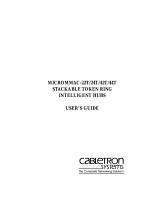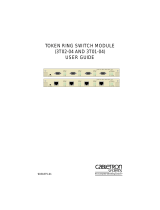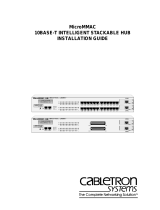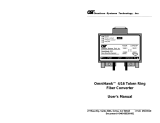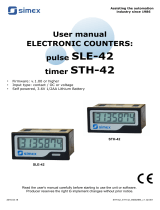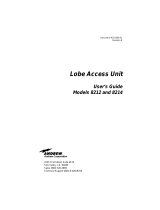Page is loading ...

MicroMMAC-22T/24T/42T/44T
USER’S GUIDE
BOOKTITLE2 OPTIONAL


i
NOTICE
Cabletron Systems reserves the right to make changes in specifications and other information
contained in this document without prior notice. The reader should in all cases consult Cabletron
Systems to determine whether any such changes have been made.
The hardware, firmware, or software described in this manual is subject to change without notice.
IN NO EVENT SHALL CABLETRON SYSTEMS BE LIABLE FOR ANY INCIDENTAL,
INDIRECT, SPECIAL, OR CONSEQUENTIAL DAMAGES WHATSOEVER (INCLUDING BUT
NOT LIMITED TO LOST PROFITS) ARISING OUT OF OR RELATED TO THIS MANUAL OR
THE INFORMATION CONTAINED IN IT, EVEN IF CABLETRON SYSTEMS HAS BEEN
ADVISED OF, KNOWN, OR SHOULD HAVE KNOWN, THE POSSIBILITY OF SUCH
DAMAGES.
Copyright 1997 by:
Cabletron Systems, Inc., P.O. Box 5005, Rochester, NH 03866-5005
All Rights Reserved
Printed in the United States of America
Order Number: 9031320-01 May 1997
SPECTRUM
,
Remote
SPECTRUM
,
Remote LANVIEW
, and
MicroMMAC
are registered
trademarks, and
CRBRIM-W/T
,
MicroSNAC-T
,
HubSTACK
,
STH
,
STHI
,
TRC 800
, and
TPIM
are trademarks of Cabletron Systems, Inc.
All other product names mentioned in this manual may be trademarks or registered
trademarks of their respective companies.
FCC NOTICE
This device complies with Part 15 of the FCC rules. Operation is subject to the following two
conditions: (1) this device may not cause harmful interference, and (2) this device must accept any
interference received, including interference that may cause undesired operation.
NOTE:
This equipment has been tested and found to comply with the limits for a Class A digital
device, pursuant to Part 15 of the FCC rules. These limits are designed to provide reasonable
protection against harmful interference when the equipment is operated in a commercial environment.
This equipment uses, generates, and can radiate radio frequency energy and if not installed in
accordance with the operator’s manual, may cause harmful interference to radio communications.
Operation of this equipment in a residential area is likely to cause interference in which case the user
will be required to correct the interference at his own expense.
WARNING:
Changes or modifications made to this device which are not expressly approved by the
party responsible for compliance could void the user’s authority to operate the equipment.
Printed on Recycled Paper

NOTICE
ii
DOC NOTICE
This digital apparatus does not exceed the Class A limits for radio noise emissions from digital
apparatus set out in the Radio Interference Regulations of the Canadian Department of
Communications.
Le présent appareil numérique n’émet pas de bruits radioélectriques dépassant les limites applicables
aux appareils numériques de la class A prescrites dans le Règlement sur le brouillage radioélectrique
édicté par le ministère des Communications du Canada.
VCCI NOTICE
This equipment is in the 1st Class Category (information equipment to be used in commercial and/or
industrial areas) and conforms to the standards set by the Voluntary Control Council for Interference
by Information Technology Equipment (VCCI) aimed at preventing radio interference in commercial
and/or industrial areas.
Consequently, when used in a residential area or in an adjacent area thereto, radio interference may be
caused to radios and TV receivers, etc.
Read the instructions for correct handling.
CABLETRON SYSTEMS, INC. PROGRAM LICENSE AGREEMENT
IMPORTANT:
Before utilizing this product, carefully read this License Agreement.
This document is an agreement between you, the end user, and Cabletron Systems, Inc. (“Cabletron”)
that sets forth your rights and obligations with respect to the Cabletron software program (the
“Program”) contained in this package. The Program may be contained in firmware, chips or other
media. BY UTILIZING THE ENCLOSED PRODUCT, YOU ARE AGREEING TO BECOME
BOUND BY THE TERMS OF THIS AGREEMENT, WHICH INCLUDES THE LICENSE AND
THE LIMITATION OF WARRANTY AND DISCLAIMER OF LIABILITY. IF YOU DO NOT
AGREE TO THE TERMS OF THIS AGREEMENT, PROMPTLY RETURN THE UNUSED
PRODUCT TO THE PLACE OF PURCHASE FOR A FULL REFUND.

NOTICE
iii
CABLETRON SOFTWARE PROGRAM LICENSE
1. LICENSE
. You have the right to use only the one (1) copy of the Program provided in this
package subject to the terms and conditions of this License Agreement.
You may not copy, reproduce or transmit any part of the Program except as permitted by the
Copyright Act of the United States or as authorized in writing by Cabletron.
2. OTHER RESTRICTIONS. You may not reverse engineer, decompile, or disassemble the
Program.
3. APPLICABLE LAW. This License Agreement shall be interpreted and governed under the laws
and in the state and federal courts of New Hampshire. You accept the personal jurisdiction and
venue of the New Hampshire courts.
EXCLUSION OF WARRANTY AND DISCLAIMER OF LIABILITY
1. EXCLUSION OF
WARRANTY. Except as may be specifically provided by Cabletron in
writing, Cabletron makes no warranty, expressed or implied, concerning the Program (including
its documentation and media).
CABLETRON DISCLAIMS ALL WARRANTIES, OTHER THAN THOSE SUPPLIED TO
YOU BY CABLETRON IN WRITING, EITHER EXPRESSED OR IMPLIED, INCLUDING
BUT NOT LIMITED TO IMPLIED WARRANTIES OF MERCHANTABILITY AND
FITNESS FOR A PARTICULAR PURPOSE, WITH RESPECT TO THE PROGRAM, THE
ACCOMPANYING WRITTEN MATERIALS, AND ANY ACCOMPANYING HARDWARE.
2. NO LIABILITY FOR CONSEQUENTIAL DAMAGES. IN NO EVENT SHALL
CABLETRON OR ITS SUPPLIERS BE LIABLE FOR ANY DAMAGES WHATSOEVER
(INCLUDING, WITHOUT LIMITATION, DAMAGES FOR LOSS OF BUSINESS,
PROFITS, BUSINESS INTERRUPTION, LOSS OF BUSINESS INFORMATION, SPECIAL,
INCIDENTAL, CONSEQUENTIAL, OR RELIANCE DAMAGES, OR OTHER LOSS)
ARISING OUT OF THE USE OR INABILITY TO USE THIS CABLETRON PRODUCT,
EVEN IF CABLETRON HAS BEEN ADVISED OF THE POSSIBILITY OF SUCH
DAMAGES. BECAUSE SOME STATES DO NOT ALLOW THE EXCLUSION OR
LIMITATION OF LIABILITY FOR CONSEQUENTIAL OR INCIDENTAL DAMAGES, OR
ON THE DURATION OR LIMITATION OF IMPLIED WARRANTIES, IN SOME
INSTANCES THE ABOVE LIMITATIONS AND EXCLUSIONS MAY NOT APPLY TO
YOU.
UNITED STATES GOVERNMENT RESTRICTED RIGHTS
The enclosed product (a) was developed solely at private expense; (b) contains “restricted computer
software” submitted with restricted rights in accordance with Section 52227-19 (a) through (d) of the
Commercial Computer Software - Restricted Rights Clause and its successors, and (c) in all respects
is proprietary data belonging to Cabletron and/or its suppliers.
For Department of Defense units, the product is licensed with “Restricted Rights” as defined in the
DoD Supplement to the Federal Acquisition Regulations, Section 52.227-7013 (c) (1) (ii) and its
successors, and use, duplication, disclosure by the Government is subject to restrictions as set forth in
subparagraph (c) (1) (ii) of the Rights in Technical Data and Computer Software clause at 252.227-
7013. Cabletron Systems, Inc., 35 Industrial Way, Rochester, New Hampshire 03867-0505.

NOTICE
iv
DECLARATION OF CONFORMITY
Application of Council Directive(s):
89/336/EEC
73/23/EEC
Manufacturer’s Name:
Cabletron Systems, Inc.
Manufacturer’s Address:
35 Industrial Way
PO Box 5005
Rochester, NH 03867
European Representative Name:
Mr. J. Solari
European Representative Address:
Cabletron Systems Limited
Nexus House, Newbury Business Park
London Road, Newbury
Berkshire RG13 2PZ, England
Conformance to Directive(s)/Product Standards:
EC Directive 89/336/EEC
EC Directive 73/23/EEC
EN 55022
EN 50082-1
EN 60950
Equipment Type/Environment:
Networking Equipment, for use in a
Commercial or Light
Industrial
Environment.
We the undersigned, hereby declare, under our sole responsibility, that the equipment packaged
with this notice conforms to the above directives.
Manufacturer Legal Representative in Europe
Mr. Ronald Fotino Mr. J. Solari
___________________________________ ___________________________________
Full Name Full Name
Principal Compliance Engineer Managing Director - E.M.E.A.
___________________________________ ___________________________________
Title Title
Rochester, NH, USA Newbury, Berkshire, England
___________________________________ ___________________________________
Location Location

v
CONTENTS
PREFACE
CHAPTER 1 INTRODUCTION
1.1 MicroMMAC-T Models.................................................................1-1
1.2 MicroMMAC-T Features..............................................................1-2
1.2.1 Lobe Port Features.........................................................1-2
1.2.2 Management Capabilities ...............................................1-2
1.2.3 Firmware Downloads To Flash EEPROM.......................1-3
1.2.4 Monitoring And Diagnostic Indicators .............................1-4
1.2.5 Ring Poll Failure Recovery .............................................1-4
1.2.6 Beaconing Protection/Recovery .....................................1-5
1.2.7 Distributed Monitoring Capabilities .................................1-6
1.2.8 UPS Monitoring Capability..............................................1-8
1.2.9 Accessories ....................................................................1-8
1.2.10 Management Information Base (MIB) Groups................1-9
CHAPTER 2 OPERATION
2.1 Turning The Hub On And Off.......................................................2-3
2.2 Control Switches And Buttons.....................................................2-4
2.2.1 Setting The Ring Speed..................................................2-4
2.2.2 Resetting The MicroMMAC-T .........................................2-5
2.2.3 Clearing NVRAM ............................................................2-6
2.3 Indicators.....................................................................................2-7
2.3.1 Describing LANVIEW LEDs............................................2-7
2.3.2 Describing The LCD System ..........................................2-8
2.4 Ports..........................................................................................2-10
2.4.1 COM Ports....................................................................2-10
2.4.2 Lobe Ports ....................................................................2-11
2.4.3 Ring In/Ring Out Ports..................................................2-12
2.4.4 STH STACK Ports ........................................................2-12
CHAPTER 3 INSTALLATION
3.1 Installing The MicroMMAC-T.......................................................3-1
3.1.1 Installation Requirements ...............................................3-1
3.1.2 Attaching The Strain-Relief Bar ......................................3-2
3.1.3 Installing The MicroMMAC-T In A Rack..........................3-3
3.1.4 Free-Standing Installation...............................................3-4

CONTENTS
vi
3.2 Installing Accessories ..................................................................3-5
3.2.1 Removing The Chassis Cover.........................................3-5
3.2.2 Removing Protection Panels...........................................3-6
3.2.3 Connectors And Ports On The Motherboard...................3-8
3.2.4 Installing The 12-Port Daughterboard.............................3-9
3.2.5 Installing The MicroSNAC-T..........................................3-11
3.2.6 Installing The CRBRIM-W/T..........................................3-12
3.2.7 Installing The LDRAM SIMM.........................................3-13
CHAPTER 4 CABLING
4.1 Token Ring Cabling Overview .....................................................4-1
4.1.1 Describing Trunk Cabling................................................4-1
4.1.2 Describing Lobe Cabling.................................................4-2
4.2 Requirements And Recommendations ........................................4-2
4.2.1 Signal Interference..........................................................4-3
4.2.2 Determining The Station Count.......................................4-3
4.2.3 Determining The Maximum Signal-Drive Distance..........4-4
4.3 Connecting Lobe Port Cabling.....................................................4-6
4.4 Connecting Trunk Cabling .........................................................4-10
4.4.1 Describing TPIMs..........................................................4-10
4.4.2 Configuring TPIMs For RI/RO Application.....................4-11
4.4.3 Installing A TPIM...........................................................4-12
4.4.4 Connecting Twisted Pair Trunk Cable Segments..........4-13
4.4.5 Connecting Fiber Optic Trunk Cable Segments............4-15
4.5 Connecting STH Stackable Hubs ..............................................4-17
CHAPTER 5 MONITORING AND TROUBLESHOOTING
5.1 Using LANVIEW LEDs.................................................................5-1
5.2 Using The LCD System ...............................................................5-2
5.2.1 Viewing Static System Messages ...................................5-2
5.2.2 Viewing Saved Alarm Messages.....................................5-3
5.2.3 Viewing Unsaved Initialization Messages .......................5-6
5.2.4 Viewing Saved System Messages..................................5-7
5.3 Monitoring The Initialization Process ...........................................5-8
5.3.1 Power Up Diagnostic Screen ..........................................5-8
5.3.2 LEDs And The LCD Panel.............................................5-10
5.4 General Troubleshooting Checklist............................................5-11

CONTENTS
vii
APPENDIX A SYSTEM SPECIFICATIONS
A.1 Operating Specifications..............................................................A-1
A.2 Power Supply Specifications.......................................................A-1
A.3 Environmental Specifications ......................................................A-2
A.4 Physical Specifications................................................................A-2
A.5 Safety ..........................................................................................A-2
A.6 EMC Requirements.....................................................................A-2
APPENDIX B TPIM SPECIFICATIONS
B.1 TPIM-T1/T2/T4 Pinouts...............................................................B-1
B.2 TPIM-F2/F3 Specifications..........................................................B-2
APPENDIX C MEDIA SPECIFICATIONS
C.1 Twisted Pair Copper Cable..........................................................C-1
C.1.1 UTP.................................................................................C-1
C.1.2 STP .................................................................................C-2
C.2 Fiber Optic Cable.........................................................................C-3
C.2.1 Multimode........................................................................C-4
C.2.2 Single-Mode....................................................................C-4
INDEX

CONTENTS
viii

ix
FIGURES
Figure 1-1 The MicroMMAC-T . . . . . . . . . . . . . . . . . . . . . . . . . . . .1-1
Figure 2-1 MicroMMAC-T Operational Components . . . . . . . . . . .2-2
Figure 2-2 Connecting To A Power Source. . . . . . . . . . . . . . . . . . .2-3
Figure 2-3 Ring Speed Switch . . . . . . . . . . . . . . . . . . . . . . . . . . . .2-4
Figure 2-4 The RESET Switch . . . . . . . . . . . . . . . . . . . . . . . . . . . .2-5
Figure 2-5 NVRAM Switch . . . . . . . . . . . . . . . . . . . . . . . . . . . . . . .2-6
Figure 2-6 LANVIEW LEDs . . . . . . . . . . . . . . . . . . . . . . . . . . . . . .2-7
Figure 2-7 LCD Panel And DISPLAY Button . . . . . . . . . . . . . . . . .2-9
Figure 2-8 COM Ports. . . . . . . . . . . . . . . . . . . . . . . . . . . . . . . . . .2-10
Figure 2-9 Lobe Ports. . . . . . . . . . . . . . . . . . . . . . . . . . . . . . . . . .2-11
Figure 2-10 Lobe Port Pinouts . . . . . . . . . . . . . . . . . . . . . . . . . . . .2-11
Figure 2-11 Ring Ports . . . . . . . . . . . . . . . . . . . . . . . . . . . . . . . . . .2-12
Figure 2-12 STH STACK Ports . . . . . . . . . . . . . . . . . . . . . . . . . . . .2-12
Figure 3-1 Strain-Relief Bar . . . . . . . . . . . . . . . . . . . . . . . . . . . . . .3-2
Figure 3-2 Attaching The Strain-Relief Bar. . . . . . . . . . . . . . . . . . .3-3
Figure 3-3 Remove Front Side Screws. . . . . . . . . . . . . . . . . . . . . .3-3
Figure 3-4 Installing Rack-Mount Brackets. . . . . . . . . . . . . . . . . . .3-3
Figure 3-5 Installing The MicroMMAC-T In A Rack. . . . . . . . . . . . .3-4
Figure 3-6 Free-Standing Installation . . . . . . . . . . . . . . . . . . . . . . .3-4
Figure 3-7 Removing Chassis Cover Screws. . . . . . . . . . . . . . . . .3-5
Figure 3-8 Removing The Chassis Cover. . . . . . . . . . . . . . . . . . . .3-6
Figure 3-9 Removing The Front Panel . . . . . . . . . . . . . . . . . . . . . .3-7
Figure 3-10 Removing The Rear Panel . . . . . . . . . . . . . . . . . . . . . .3-8
Figure 3-11 Connectors And Ports For Accessories . . . . . . . . . . . .3-9
Figure 3-12 Installing The 12-port Daughterboard . . . . . . . . . . . . .3-10
Figure 3-13 Installing The MicroSNAC-T Daughterboard. . . . . . . .3-12
Figure 3-14 Installing The CRBRIM-W/T . . . . . . . . . . . . . . . . . . . .3-13
Figure 3-15 Removing The LDRAM SIMM. . . . . . . . . . . . . . . . . . .3-14
Figure 3-16 Installing The LDRAM SIMM. . . . . . . . . . . . . . . . . . . .3-14
Figure 4-1 Trunk And Lobe Cabling Configuration . . . . . . . . . . . . .4-1
Figure 4-2 UTP Lobe Cabling Example . . . . . . . . . . . . . . . . . . . . .4-7
Figure 4-3 STP Lobe Cabling Example . . . . . . . . . . . . . . . . . . . . .4-8
Figure 4-4 Connecting To A Lobe Port . . . . . . . . . . . . . . . . . . . . . .4-9
Figure 4-5 TPIMs . . . . . . . . . . . . . . . . . . . . . . . . . . . . . . . . . . . . .4-10
Figure 4-6 TPIM Configuration Settings . . . . . . . . . . . . . . . . . . . .4-11
Figure 4-7 Installing A TPIM . . . . . . . . . . . . . . . . . . . . . . . . . . . . .4-12
Figure 4-8 Connecting To The TPIM-T1 . . . . . . . . . . . . . . . . . . . .4-13
Figure 4-9 Connecting To The TPIM-T4 . . . . . . . . . . . . . . . . . . . .4-13

FIGURES
x
Figure 4-10 Connecting To The TPIM-T2 . . . . . . . . . . . . . . . . . . . .4-14
Figure 4-11 Connecting To The TPIM-F2/-F3 . . . . . . . . . . . . . . . . .4-16
Figure 4-12 MicroMMAC-T/STH Stack Configuration. . . . . . . . . . .4-17
Figure 5-1 Power Up Diagnostic Screen. . . . . . . . . . . . . . . . . . . . .5-8
Figure B-1 TPIM-T1/T2/T4 Pinouts . . . . . . . . . . . . . . . . . . . . . . . . B-1

xi
TABLES
Table 4-1 Maximum Lobe Cable Lengths . . . . . . . . . . . . . . . . . . .4-5
Table 4-2 Maximum Trunk Cable Lengths. . . . . . . . . . . . . . . . . . .4-5
Table 4-3 Connector Pinout Cross-Reference . . . . . . . . . . . . . . .4-8
Table 4-4 TPIM Models. . . . . . . . . . . . . . . . . . . . . . . . . . . . . . . .4-10
Table 5-1 LANVIEW LEDs . . . . . . . . . . . . . . . . . . . . . . . . . . . . . .5-1
Table 5-2 Static System Messages. . . . . . . . . . . . . . . . . . . . . . . .5-2
Table 5-3 Alarm Messages . . . . . . . . . . . . . . . . . . . . . . . . . . . . . .5-3
Table 5-4 Unsaved Initialization Messages. . . . . . . . . . . . . . . . . .5-6
Table 5-5 Unsaved Failure Or Error Messages. . . . . . . . . . . . . . .5-6
Table 5-6 Saved System Messages . . . . . . . . . . . . . . . . . . . . . . .5-7
Table 5-7 Power Up Indications From LEDs And The LCD. . . . .5-10
Table A-1 Power Supply Outputs. . . . . . . . . . . . . . . . . . . . . . . . . .A-1
Table B-1 TPIM-F2 Receiver Specifications . . . . . . . . . . . . . . . . .B-2
Table B-2 TPIM-F2 Transmitter Average Power. . . . . . . . . . . . . . .B-2
Table B-3 TPIM-F3 Specifications. . . . . . . . . . . . . . . . . . . . . . . . .B-3
Table C-1 UTP Performance Specifications. . . . . . . . . . . . . . . . . .C-2
Table C-2 STP Cable Specifications . . . . . . . . . . . . . . . . . . . . . . .C-3
Table C-3 Signal Tolerances For Multimode Fiber Optic Cable . . .C-4
Table C-4 Signal Tolerance For Single-Mode Fiber Optic Cable . .C-4

TABLES
xii

xiii
PREFACE
Welcome to the Cabletron Systems
MicroMMAC-22T/24T/42T/44T
User’s Guide
. This guide describes how to install, configure, and operate
the MicroMMAC-T family of intelligent, stackable Token Ring wiring
hubs. This guide is intended for all users of the MicroMMAC-T, who
should have a basic understanding of the IEEE 802.5 standard for Token
Ring networks, especially of physical components used in Token Ring
networks.
DOCUMENT CONVENTIONS
The following conventions are used throughout this manual:
Bold Italics
are used for references in non-tabular text to Cabletron
Systems publications and other publications.
MicroMMAC-T collectively refers to the MicroMMAC-22T,
MicroMMAC-24T, MicroMMAC-42T, and MicroMMAC-44T in this
manual unless specified otherwise.
“
uMMAC-T
”
is an abbreviated version of MicroMMAC-T used in select
LCD system messages described in this manual.
NOTE
Note
calls your attention to information of special importance.
!
CAUTION
Caution
calls your attention to information you should heed to
avoid potentially damaging firmware, configuration settings, or
equipment.
Hazard
calls your attention to potential electric shock hazard.

PREFACE
xiv
USING THIS MANUAL
This manual’s contents is organized as follows:
Chapter 1,
Introduction
, describes MicroMMAC-T model types and
features.
Chapter 2,
Operation
,
describes how to connect the MicroMMAC-T to a
power source, how to work with operational components, and the
functions of MicroMMAC-T ports.
Chapter 3,
Installation
,
describes installation requirements, how to install
the MicroMMAC-T, and how to install accessories.
Chapter 4,
Cabling
, describes cabling guidelines for Token Ring
networks and how to connect network cable to MicroMMAC-T lobe, ring,
and stack ports.
Chapter 5,
Monitoring and Troubleshooting
, describes how to use the
system-message LCD, LANVIEW LEDs, and the Power Up Diagnostic
screen to monitor the operational status of the MicroMMAC-T and the
Token Ring network.
Appendix A,
System Specifications
, lists various system and safety
specifications.
Appendix B,
TPIM Specifications
, provides physical and operational
specifications for Token Ring Port Interface Modules (TPIMs).
Appendix C,
Media Specifications
, describes design and performance
specifications for the cable types used with the MicroMMAC-T.

PREFACE
xv
RELATED DOCUMENTATION
This section lists installation and operation manuals included with the
MicroMMAC-T and STH hubs and accessories typically used with the
MicroMMAC-T. Refer to documentation listed for the device you are
working with for specific information about installing, operating, or
managing the device.
The following publications provide information about Local Area
Networks (LAN) and their implementation.
Local Area Networks, IEEE Standard 802.5 Token Ring Access
Method, And Physical Layer Specifications
Commercial Building Wiring Standard
, EIA/TIA-568A Standard
Device Installation/Operation Management
MicroMMAC-T
MicroMMAC-22T/24T/42T/44T
User’s Guide
Console Cable Kit Instruction
Sheet
MicroMMAC-T
Unpacking/Parts Sheet
MicroMMAC-T Local
Management Guide
STH-22/24/42/44 STH-22/24/42/44 User’s Guide
MicroMMAC-T Local
Management Guide
CRBRIM-W/T CRBRIM-W/T User’s Guide
CRM-DOC (multi-volume
set)
MicroSNAC-T
MicroSNAC User’s Guide
MicroSNAC Advanced Topics User’s Guide
LDRAM SIMM
Upgrade Kit
SIMM Installation Instruction
Sheet
Not Applicable

PREFACE
xvi
GETTING HELP
If you need technical assistance with your MicroMMAC-T or have any
questions, comments, or suggestions concerning this manual, contact
Cabletron Systems Technical Support using any of the following
methods:
Before calling Cabletron Systems Technical Support, have the following
information ready:
•
A description of the failure
•
A description of any action(s) already taken to resolve the problem
(e.g., rebooting the unit)
•
A description of your network environment (layout, cable type, etc.)
•
Network load and frame size at the time of trouble (if known)
•
The serial and revision numbers of all Cabletron Systems products in
the network (MicroMMAC-T information listed on its Local
Management Password screen)
•
The device history (i.e., have you returned the device before, is this a
recurring problem?)
•
Any previous Return Material Authorization (RMA) numbers
Phone (603) 332-9400
Monday – Friday; 8
A
.
M
. – 8
P
.
M
. Eastern Time
CompuServe GO CTRON from any ! prompt
Internet mail [email protected]
FTP ctron.com (134.141.197.25)
Login
anonymous
Password
your email address
BBS (603) 335-3358
Modem setting 8N1: 8 data bits, 1 stop bit, No parity
For additional information about Cabletron Systems products and
services, visit our World Wide Web site: http://www.cabletron.com/

1-1
CHAPTER 1
INTRODUCTION
The MicroMMAC-T, shown in Figure 1-1, is an IEEE 802.5-based,
IBM-compatible, SNMP-compliant, intelligent, stackable Multi-Media
Access Center (MMAC). The MicroMMAC-T is a versatile wiring hub
into which you can install a variety of products designed to provide a
range of functions to meet your particular network requirements. It
supports connection to up to four Cabletron Systems non-intelligent,
active STH hubs, allowing you to constitute one or more Token Ring
networks from a stack configuration.
Figure 1-1 The MicroMMAC-T
1.1 MicroMMAC-T MODELS
All MicroMMAC-Ts are functionally and physically identical except for
the number and type of their lobe, or Trunk Connection Unit (TCU),
ports. MicroMMAC-T models are listed as follows:
•
MicroMMAC
-
22T
– 12 active RJ45 lobe ports that support category
3, 4, and 5 UTP cabling
•
MicroMMAC
-
24T
– 24 active RJ45 lobe ports that support category
3, 4, and 5 UTP cabling
•
MicroMMAC-42T
– 12 active, shielded RJ45 lobe ports that support
IBM Type 1, 2, 6, and 9 STP cabling
•
MicroMMAC-44T
– 24 active, shielded RJ45 lobe ports that support
IBM Type 1, 2, 6, and 9 STP cabling
R
DISPLAY
RESET
4M 16M
SPEED
CPU
16Mb/s
ACT
MGMT
RO
24 23 22
21 20 19
18 17 16
15 14 13
12 11 10
9 8 7
6 5 4
3 2 1
MicroMMAC-24T
TOKEN RING HUB
WITH
LANVIEW
SUPPORTING 100 OHM UTP CABLE
COM 1
COM 2
RI
24 23 22 21 20 19
18 17 16 15 14 13
12 11 10 9 87 654321
CABLETRON
MicroMMAC-24T
CONSOLE
PORT 2
PORT 1
RST
XMT
RCV
XMT
RCV
MicroSNAC-T
FLT ACT
V35
NMI
Consolidated SNA/SDLC, BSC,
Media-Flexible
Ring Port
Management Access
and UPS Monitoring
RO Convertible
Lobe Ports
(CRBRIM-W/T) Router/WAN Interface
LAN, WAN Connectivity (MicroSNAC)
Connection
LANVIEW LED System
Monitoring and DiagnosticsMo
Message LCD
System-Event

INTRODUCTION
1-2
1.2 MicroMMAC-T FEATURES
This section provides an overview of MicroMMAC-T features.
1.2.1 Lobe Port Features
This section overviews lobe port features.
Repeater Circuitry
Repeater circuitry in the MicroMMAC-T enables lobe ports to regenerate,
reshape, and filter the incoming signal, permitting UTP lobe cable lengths
of up to 120 meters and STP lobe cable lengths up to 150 meters for a
16 Mbps network.
Speed Fault Protection
The MicroMMAC-T automatically disables any lobe port that detects a
station connected to it from trying to enter the ring at the wrong
operational speed. This prevents the station from causing a beaconing
condition on the ring. A lobe port’s associated Lobe Port Status LED
blinks red to indicate that the port has detected a speed fault violation and
has been put into the bypassed mode. (See Section 5.1 for information
about monitoring the MicroMMAC-T using LANVIEW LEDs.)
Lobe Port To Ring Port Conversion
Lobe ports can be converted through management to Ring Out (RO)
ports, supporting connection
only
to
passive Multi-Station Access Units
(MSAUs) such as the Cabletron Systems TRC-800 or the IBM 8228.
1.2.2 Management Capabilities
The MicroMMAC-T supports both in-band and out-of-band access to
embedded management applications and MIBs.
Local Management (LM)
LM comprises a set of basic monitoring and configuration applications
you can use to manage up to 120 ports on the combined MicroMMAC-T
and STH stack. You can gain out-of-band access to LM using a VT-series
terminal or a PC running a VT-series emulation program from either a
direct cable connection or remote modem connection to either of the
MicroMMAC-T’s front-panel RS-232C COM ports.
/
